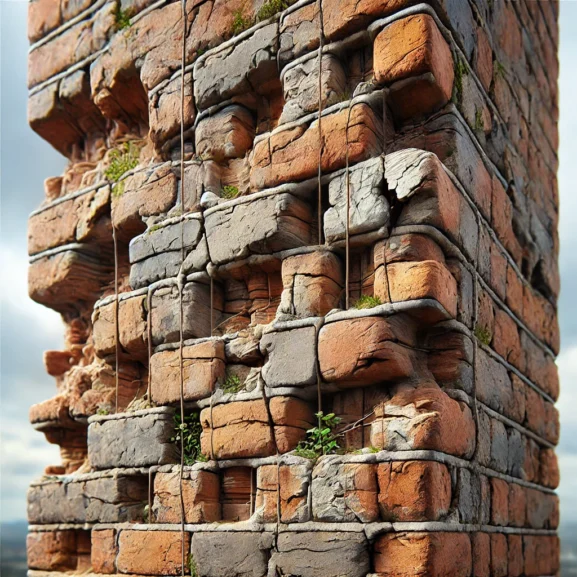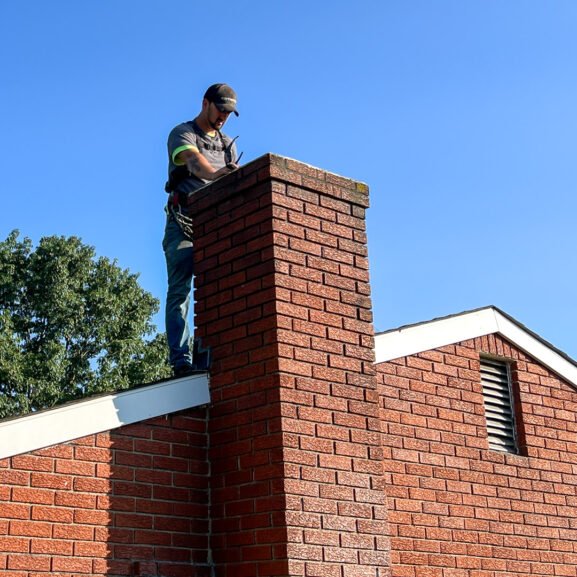Lack of Chimney Rain Covers Causing Water Entry: Protect Your Home Now
We’ve all heard the saying, “When it rains, it pours.” This saying can be all too true for homeowners without chimney rain covers. Chimneys are often ignored when we maintain our homes. But they are important. They help protect our homes from the weather. However, chimneys can allow water to enter without a proper rain cover and cause damage.
Water entering through chimneys can cause problems. It can damage the structure. It can also lead to mould growth. It’s surprising how much of a difference a small cover can make. This article will explain why chimney rain covers are so important. We’ll also look at how their absence can lead to expensive repairs. Let’s keep our homes dry and safe. We can do this by understanding the value of this simple, but essential chimney accessory.
What You Need to Know About Chimney Rain Covers
Chimney rain covers, also known as chimney caps, play a big role in preventing water entry into chimneys. They shield the opening from rain and snow, stopping water from damaging the interior. Without these covers, water can get in, causing serious problems like mold growth and damage to the chimney, which can lead to expensive repairs.
Benefits of Chimney Rain Covers
- Waterproofing: Rain covers prevent water from entering the chimney’s flue, helping to protect the structure and its contents.
Animal Deterrent: Covers keep animals from nesting in the chimney. This prevents airflow blockages and reduces hazards.
Debris Exclusion: Covers keep leaves and debris out of the chimney, helping keep the ventilation clear and working properly.
Challenges
The weather can change a lot, making chimney cap protection important. We often deal with rain and snow, which means we need strong waterproofing solutions for our chimneys. If the rain cover is missing or broken, it can lead to problems, especially during snowy winters or rainy seasons.
Why Hire Professionals?
Installing a rain cover isn’t a DIY job—it might cause more harm than good. Reach out to professionals for consultation. We’ll make sure your rain cover is installed and maintained properly. Trained experts guarantee long-term prevention of chimney leaks and safeguard your home effectively.
Further Reading
For more information, explore resources from the National Fire Protection Association and the Chimney Safety Institute of America. These offer expert advice on keeping chimneys safe and sound.
Consequences of Not Having a Chimney Rain Cover
A missing chimney rain cover can lead to costly and preventable issues. Let’s look at some of the problems that can happen. We’ll also see how installing proper rain covers can help prevent them.
Water Damage to the Structure
Water entry in chimneys can wreak havoc on a home’s structure. Without chimney cap protection, rainwater can seep into brickwork and mortar. This eventually weakens these materials over time. Unchecked water damage to chimneys can lead to cracks, posing serious risks. Plus, repair costs can pile up. Remember, no one wants to deal with a soggy situation! To keep water damage at bay, reach out to professionals for consultation and ensure rain cap installation is done professionally. For more on chimney safety, check the Chimney Safety Institute of America.
Increased Risk of Mold and Mildew
When water enters your chimney, mould and mildew are likely to follow. These pesky intruders thrive in damp environments. They damage the structure and pose health risks to your family. The dampness in the chimney can cause mould to grow. Once the mould is there, it can spread through your home. The HVAC system helps carry the spores to different rooms. This can cause allergies and respiratory issues. To avoid these health hazards, installing a chimney rain cover is crucial. Our chimney waterproofing services are effective. Let us protect your chimney from moisture. Learn more about mould prevention and healthier home environments from the Environmental Protection Agency.
Damage to Fireplace Components
Chimney components can take a hit when water enters. When moisture is present, rust forms on the metal parts, including the damper and firebox. Over time, this rust compromises their functionality and safety. Imagine not being able to enjoy a cosy fire because of a rain-soaked damper! Preventing chimney leaks protects these components and keeps your fireplace functional and safe. We don’t advise DIY solutions—these jobs need professional handling for peace of mind.
Signs of Water Entry Through the Chimney

Water entry in a chimney can lead to various problems if rain cover is absent. Here are some signs to watch out for that indicate it’s time to consider chimney cap protection.
Visible Water Stains
Water stains are a clear indicator of issues. They appear on walls and ceilings near the chimney. Brown or discolouration might suggest water damage has already occurred. If water stains remain untreated, mould can start growing. We highly recommend a professional evaluation. Reach out to professionals for consultation.
Deteriorating Masonry
Deteriorating bricks mean water damage in the chimney. Crumbling mortar and cracked bricks signal water entry. Our team can provide chimney waterproofing services to prevent further damage. A rain cap installation can stop future leaks and costly repairs.
Unpleasant Odors
Unpleasant smells hint at chimney issues. Moisture can cause mould and mildew, resulting in bad odours. A chimney cap is crucial to stopping rain from entering and causing these smells. Reach out to us if you need more help. You can also read helpful advice on chimney safety. The Chimney Safety Institute of America offers useful tips. For fire safety tips, see the National Fire Protection Association.
How to Address Water Entry Issues

Addressing water entry issues involves a few simple yet crucial steps. Focusing on prevention is important. It helps homeowners avoid damage and saves money on expensive repairs.
Installing a Chimney Rain Cover
First, let’s talk about installing a chimney rain cover. A well-fitted rain cover, known as a chimney cap, offers vital protection. It keeps water, debris, and even adventurous critters out. Sealing the top of your chimney prevents chimney leaks and potential water damage. Our team ensures precision in rain cover installation, leaving no room for error.
Considerations include:
- Ventilation: Allows smoke to escape while keeping rain out.
- Materials: Choose stainless steel or copper for durability.
- Sizing: Ensure it fits snugly for maximum effectiveness.
For help with chimney cap protection, reach out to professionals for consultation. We’ll schedule a free consultation for you.
Regular Chimney Maintenance
Regular chimney maintenance is more than a chore; it’s a rescue mission for your home. Without it, water infiltration can lead to severe damage.
Focus areas include:
- Annual Inspections: Detect leaks or masonry damage.
- Cleaning: Remove soot and blockages to improve ventilation.
- Repairs: Fix deteriorating bricks and mortar before they worsen.
The harsh weather necessitates unique care. For the best results, skip the DIY adventures and rely on professionals. For more on chimney safety, the Chimney Safety Institute of America provides trusted advice.
Need help with chimney waterproofing? Reach out to professionals for consultation. The National Fire Protection Association offers great safety tips.
Choosing the Right Chimney Rain Cover
Choosing the right chimney rain cover is important. It helps stop water from getting into your chimney and keeps your chimney cap safe. If you’re worried about water damage or animals getting in, we can help.
Material Considerations
Chimney rain covers come in various materials, each with its strengths.
- Stainless Steel: This is a top choice for durability. It’s rust-resistant and requires minimal maintenance. This is perfect for anyone who wants to “set it and forget it.” It’s like how we all try to forget about that last snowstorm!
- Copper: It offers elegance and lasts a long time. Though pricier, it adds a touch of class while withstanding harsh weather.
- Galvanized Metal: While budget-friendly, it might not hold up well against the frequent rain. This is because it is more likely to rust compared to other materials.
Choosing the right material helps prevent chimney leaks, making it a worthwhile investment. For detailed guidance, check with the Chimney Safety Institute of America.
Professional Installation
A professional installation is crucial for effective rain cover usage. Proper placement ensures chimney waterproofing and extends chimney life.
- Expert Knowledge: Our technicians know exactly how to fit covers. This keeps water from getting in.
Tools: We use the right tools to make the job easier. These tools help avoid problems.
Safety: We don’t recommend climbing roofs. Leave it to the pros. They know how to handle heights and install rain caps safely.
Reach out to professionals for consultation. We’ll connect you with a pro who meets your needs. For more safety tips, visit the National Fire Protection Association.
Conclusion
We need to have rain covers on our chimneys. This helps protect our homes from water damage. Rain can cause a lot of harm to chimneys. The cover keeps the rain out and keeps our homes safe. It helps reduce the risks that come with it. We can avoid expensive repairs by choosing professional installation and the right materials. This also keeps our living space safe and dry. Let’s take action now to protect our chimneys. We’ll have peace of mind knowing our homes are safe from the weather. Investing in strong chimney protection is a must in areas, where the weather can be tough.
Frequently Asked Questions
What is a chimney rain cover, and why is it important?
A chimney rain cover, or chimney cap, is a protective cover for your chimney. It sits on top to keep water out. Water can cause structural damage and mould, so the cover helps prevent this. The cap also keeps out debris and animals. This helps maintain good ventilation and can save you from expensive repairs.
Can I install a chimney rain cover myself?
You can install it yourself, but it’s not recommended. Professionals know how to install the chimney rain cover properly. They use the right tools and techniques, which helps avoid leaks and ensures your chimney is protected for a long time.
What material should I choose for a chimney rain cover?
The best material for a chimney rain cover depends on what you need. Stainless steel is durable. Copper looks elegant. Galvanized metal is more affordable. Choosing the right material is important. It helps prevent leaks and makes sure the cover works well.
How can I tell if my chimney needs a rain cover?
If you see water stains on your walls or ceilings, it’s a sign that a rain cover might be needed. Other signs include crumbling mortar, cracked bricks, and mouldy smells. These all suggest moisture is getting in. It’s important to have a professional check and install a rain cover to prevent further damage.
Is it necessary to have chimney rain cover protection?
In some regions, rain and snow happen often. That’s why strong chimney protection is a must. Chimney rain covers protect your chimney from water damage. They also help keep your home’s structure intact. This can save you from expensive repairs. A good rain cover will waterproof your chimney and keep it safe.
What are the risks of not having a chimney rain cover?
Without a chimney rain cover, your home could suffer water damage. Water can seep into the brick and mortar, weakening the structure and causing mould and mildew to grow. Over time, your fireplace components may deteriorate, leading to costly repairs.
Where can I get professional help for chimney rain cover installation?
You can find professional services for installing chimney rain covers by consulting experts in chimney care. They can help you choose the right cover for your chimney. Their experience ensures a proper installation to protect your home from rain damage. These experts provide the cover is installed correctly and help prevent leaks. For trusted services, check resources like the National Fire Protection Association.


